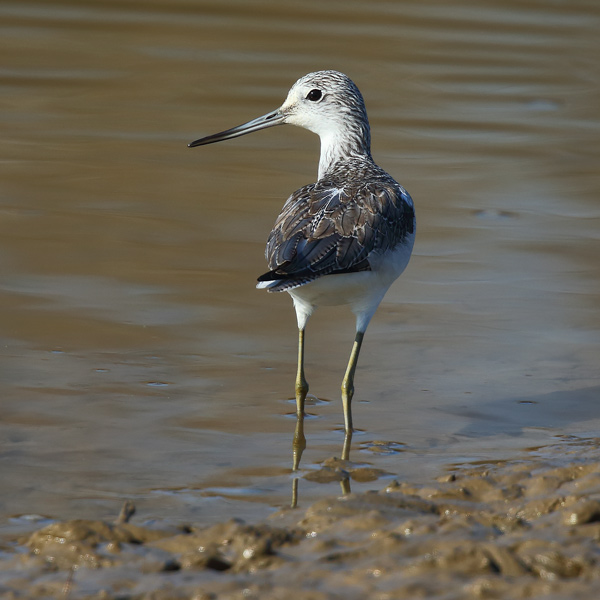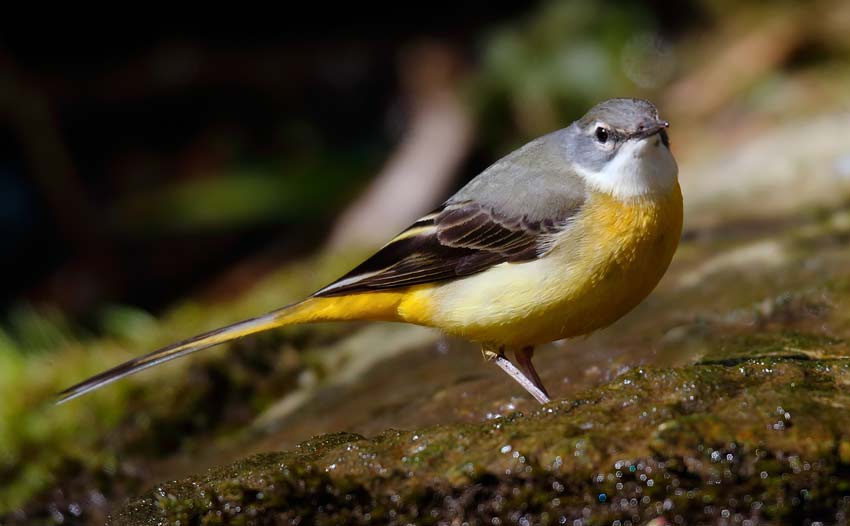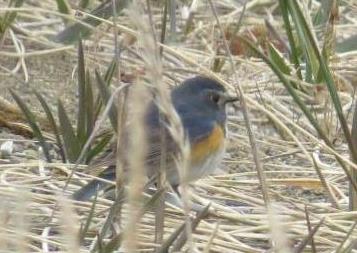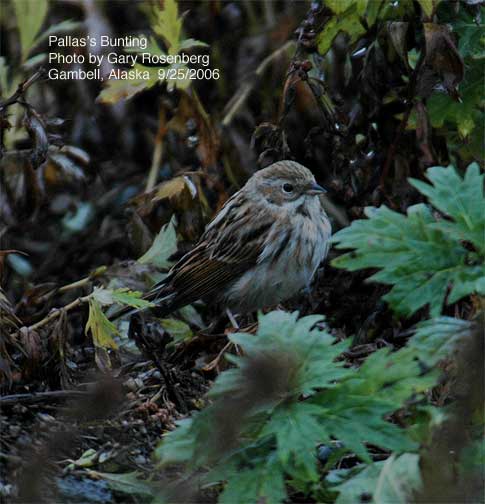Alaska, The Last Frontier Attu Island
By Sandy Komito
Extracts from his book; "I came, I saw, I counted"
Comments"Soon, a female Rustic Bunting lands on the ground less than forty feet from where we are standing."
Last night, we all saw a pair of Eye-browed Thrushes by merely looking out the dining room window. This morning starts with light winds still continuing out of the west. With yesterday's overload of birds, I wonder if this could possibly continue. By nine-thirty, I am bicycling to the airport runways, to see a reported Common Greenshank. Just before reaching the runways, I see Gloria Wachtler speeding towards me on her bicycle. "What's up?" I ask. "Pechora Pipit at Pratincole Beach!" and with that, she speeds south along the Casco Cove Road. Deciding to hold off on the Greenshank, I turn my bicycle around and try following her. The distance between us widens as she pours on the speed while I can only mope along.
The way I'm moving it looks like I'm dragging a cinder block with a rope tied to my bicycle.
I eventually arrive at Pratincole Beach and see a long line of birders spread out in an apparent effort to flush the bird that's now out of sight. I look towards Joe Swertinski, who says in a soft voice, "I have the bird in the wrack line." Being the first person behind him, I get to view the pipit in his telescope. We're so close, the bird literally fills half the view. I spend very little time socializing, returning instead to my bicycle and pedaling into the wind. I'm on my way back to the runway ponds some four miles away, hoping the Common Greenshank is still waiting.
I begin my search by checking out a number of Wood Sandpipers but I still cannot find the Greenshank. Joe Swertinski soon appears with his telescope and we check out one more large sandpiper partially hidden in the reeds along the far shore. This turns out to be the Common Greenshank we've all been searching for. I start to move closer to photograph it when I realize that some birders still haven't seen it. Since I don't want to press the bird, lest it fly away, I back off with just a few long-distance, barely identifiable shots. By now, its lunch time so several of us select a resting place out of the wind, overlooking the Peaceful River.

After a relatively short lunch period, Elie Elder tells me, "a Gray Wagtail has been reported by Steve Heinl along the Gilbert Ridge Road." In the opposite direction, towards South Beach, a Red-necked Stint is also reported. Now I have to make a decision. Shorebird or passerine? I opt for the wagtail, some five miles away.
The road is rough and wet with many potholes and several large sections where snow completely covers the road. In one place, I have to push my bicycle for nearly a quarter mile through the soft snow before I can resume cycling.
When I arrive near the base of the Gilbert Ridge Mountains, I see a group of seven people, several hundred yards away, heading towards me. I stop to photograph Gray-crowned Rosyfinch and Eye-browed Thrush before catching up to the group. They report, "No luck with the Gray Wagtail. It was chased by some Lapland Longspurs up one of the ravines and disappeared." That sinking feeling I've had many times before returns. "However, there's a pipit over there," one of the participants says, as he points to a pile of old lumber. We flush the bird a couple of times, seeing its buffy outer tail feathers and prominent white streaking on its back. I realize it's another Pechora Pipit. It's a great bird, but I really want the wagtail. How quickly we become blasé (and the Pechora is a Code 5 bird)! After a while, our leader Steve Heinl suggests we return to check where the wagtail had been. Sure enough, there it is feeding along the edge of a large snow field. I look through Steve's scope a couple of times, satisfied at finally seeing one of the rarest of the North American wagtails.
I need to be in a more central location, in case something else shows up. Bicycling towards the airport runways, I hear a report of a Jack Snipe near Casco Cove. This is a Code 5 bird that demands immediate attention. Five miles of bicycling into the wind means nothing when chasing after an accidental bird such as this one.
As I begin my race, winds of up to fifty miles per hour are blasting me with frozen rain mixed with sleet. The Weather Gods conspire to make me suffer for each of the rare birds I hope to see. I am beginning to get soaked from the driving rain but will not be deterred in my quest for this bird. It seems as though every afternoon has had increasingly strong winds, at times so strong, I have to dismount and just walk my bike.

Upon reaching the Casco Cove overlook, I find a large group of birders sweeping across the tundra. It seems they are concluding the sweep and will continue it tomorrow. It is at this time I learn the bird seen was not a Jack Snipe but a Pintail Snipe. The Pintail Snipe is also a great bird but it's not a life bird like the Jack Snipe would be.
I return to my bike and slog back to Lower Base for the last three miles, fighting the gale force winds all the way home. After dinner, another Pechora Pipit is discovered on the road just above our quarters. An amazing end to a fabulous day. Not only are the birds of great rarity but the numbers are also most impressive.
May 31st
It is a restful morning suddenly shattered by the report of a Red-flanked Bluetail in Upper Henderson (West Massacre). Off and running, I fight a strong northeast wind for nearly six miles. Driving my bicycle to a point where the road is virtually washed out, I park it alongside a dozen others. Now begins the nearly mile and a half hike to where drifting snows spread across the road. Half a mile beyond this, I see a line of people so I'm at least going in the right direction. I next have to ford a fast flowing stream, being careful not to slip on the rocks or plunge into areas deeper than eight inches. Slowly walking into the stream seems to cause the fast flowing waters to rise an inch or two above the top of my boots. Therefore, my course of action is to literally run through the water as fast as I can, to a gravel bar on the far side. From there, I find a more or less shallow area and repeat the run. Surprise of surprises! It actually works; no water manages to get into my boots.

Working my way behind the back of the group, I quickly join them. "Is the bird still around?" I gasp. "Yes." "Where?" "Somewhere near the bend in the stream, over there," as they point to the place it had last been seen. I am frankly feeling a bit uneasy about this. It's too easy for a skulking like this one to get away without anyone seeing it.
After a ten minute wait, someone shouts, "There it is, in the willows." All eyes turn to the approximate place, as a couple of people shout directions. "There, it's coming closer to us," but not all eyes can find it. "It's still moving, closer still." "How far?" "Forty feet and closing!" It is then that I get my first good look at the bird. It pauses, looks around, perhaps a bit bewildered, and flies briefly to the top of a willow. It stays for just a few moments before flying down into the willows for better concealment. Judging by the bird's brightness, it appears to be a male in basic plumage. It is an exciting moment as we continue to view the bluetail and get telescope looks at it. All of the sixty people manage to eventually get satisfactory looks at this most uncommon passerine.
The journey back to base is temporarily interrupted by a stop near Brambling Bluff where a group of us study the various waterbirds on Massacre Bay. After the five o'clock radio check fails to provide word on any new birds, we all head "back to the barn." No other reports come in for the rest of the day and I am able to once again try and rest my weary bones. So far, this month, I've been able to add forty-five new birds, bringing my year's total to 645.
 Attu Fall 2006
Attu Fall 2006 Gambell Fall 2006
Gambell Fall 2006 Attu Fall 2000
Attu Fall 2000